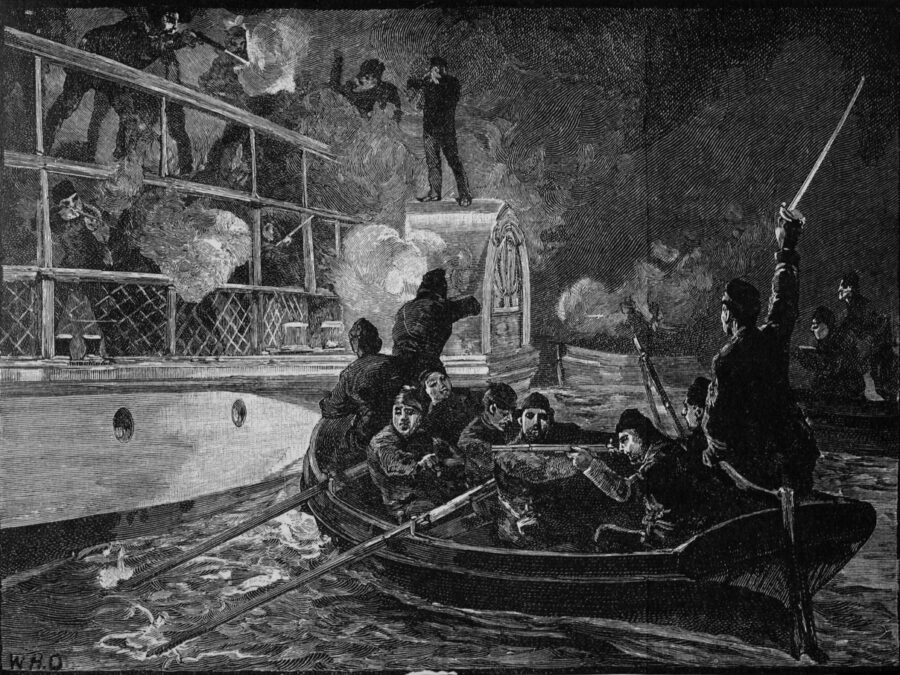
Daniel Dobbins is best known for his role in the construction of the U.S. Navy’s Great Lakes fleet that, under the command of Commodore Oliver Hazard Perry, defeated the British in the Battle of Lake Erie during the War of 1812. Following his sometimes-stormy naval career, he joined the Revenue Marine, commanding revenue cutters on the Great Lakes, and, briefly, on the Atlantic Coast. He served in the Revenue Marine in the days when overt political patronage ruled the officer corps. This led him to a career-long, colorful rivalry with another pioneering Great Lakes cutterman, Capt. Gilbert Knapp. This is their story.
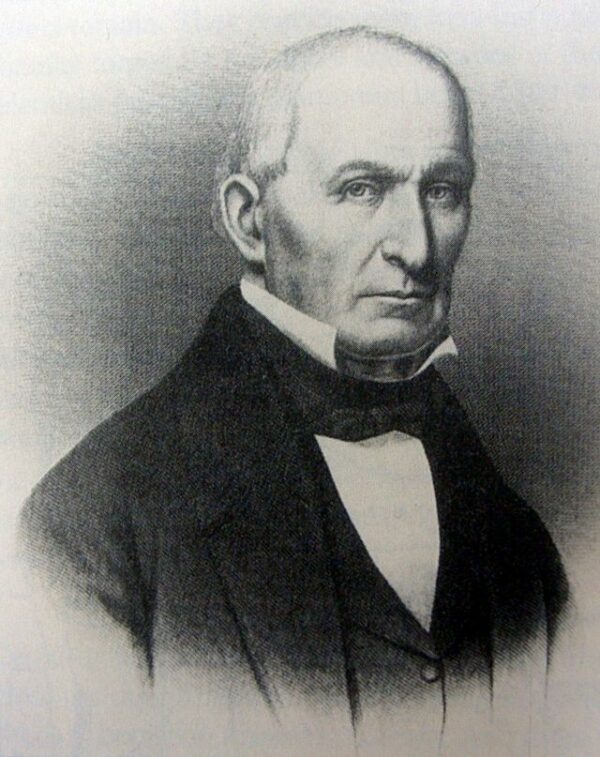
Frontier Mariner
On a cold, wintery December day in 1796, a small group of men gathered at Presque Isle (Erie), Pennsylvania, for the funeral of Gen. Anthony Wayne, famous Indian fighter, and soldier of the Revolutionary War. With the nation’s military hero dressed in his uniform, the attendees laid him to final rest. As the general had requested, it was a simple affair. A pine coffin and low-key ceremony in sharp contrast to the exciting life gallant Wayne had led.
Among those in attendance at this somber event was a proud young man of 20 named Daniel Dobbins. The occasion was an impactful reminder that the frontier Wayne had helped tame was now open to young men to settle and “civilize.” It helped shape Dobbins’ life as a fervent, lifelong patriot and a pioneer set on transforming the Great Lakes region.
At the beginning of the 19th century, the Great Lakes area was very much an untamed wilderness. Everything and everybody moved by water. Those who became skilled at navigating the “Inland Seas” were essential and highly valued.

Despite the fact that the Northwest Territory belonged by treaty to the United States, the British continued to exercise greater influence and control. Inhabitants remained tied to a long-established trading economy integrated with British Canada. By the late 1760s, a small number of British vessels and their naval establishment in the Great Lakes were structured into what was called the “Provincial Marine.” American independence in 1783 had little impact on the status quo and maritime transport and patrol services remained a British monopoly. Privately-owned vessels were not allowed until 1785. However, merchants screamed loudly enough that government, both British and American, eased the trading restrictions and authorized commercial firms to build and operate private merchant ships.
The lure of maritime commerce drew Dobbins, now a landowner in Erie, to his life’s work. Dobbins got involved in lake navigation at a time when there were few boatmen and even fewer boats at Presque Isle. In the spring of 1803, Dobbins had acquired all he needed to know about commanding a vessel. He became master of the 30-ton sloop Good Intent and launched his career as a prosperous merchant mariner. Lake Erie became increasingly important in the westward movement of settlers hoping to explore and exploit the riches of the West.
The War of 1812
The worst place for an American to be in the spring of 1812 was anywhere along the Canadian border—it was like a winding stretch of gunpowder ignited on one end. War with Britain once again loomed on the near horizon. In July 1812, when Dobbins sailed Salina into the harbor at Mackinac Island, Michigan, he knew something was wrong. Traders were absent and the community was on edge. On July 17, 1812, a British force entered the port, captured Fort Michilimackinac, and seized several merchant ships including the Salina. Thus, Dobbins became involved in the War of 1812 before he knew it had been declared. It marked the beginning of a saga for both him and the nation. Under the terms of capitulation, Dobbins along with other Americans, were paroled despite his refusal to sign an oath not to take up arms in the future. Dobbins sailed Salina from Mackinac as a “cartel,” with orders to report to Fort Malden in Amherstburg, Ontario. The historical details are sketchy, but at some point, en route he and his ship joined the U.S. forces defending Detroit. When General Hull surrendered Detroit, Dobbins once again became a prisoner of British forces. He was recognized and charged with being under arms, violating his Mackinac parole, a transgression punishable by death. However, Dobbins enjoyed a friendly relationship with many of the British officers and was allowed to sail to Cleveland aboard a surrendered schooner with other paroled U.S. prisoners. He eventually made his way home to Erie.
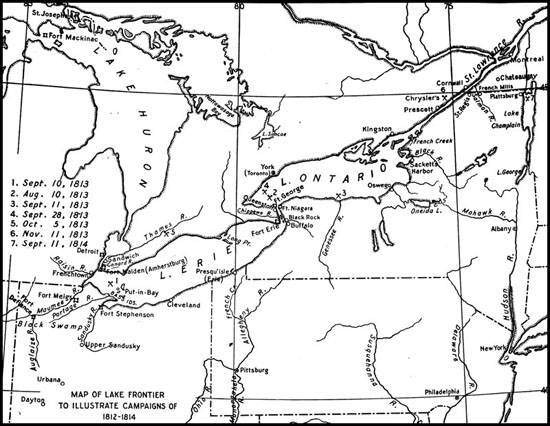
Dobbins’s misadventures in the early days of the War of 1812 convinced him of the vulnerability of U.S. territories on the Great Lakes. So, after spending a few days with family and meeting Gen. David Mead, commander of the Pennsylvania Militia, he left for Washington to apprise the administration of the situation. Dobbins discussed the naval situation and the impact of losing of the Great Lakes would have on the American cause. He also recommended that an expanded U.S. fleet be built in Erie. His plan was approved with instructions from the Secretary of the Navy to return to Erie and there “contract for, on the best terms in your power, all the requisite timbers & other materials for building four Gunboats—agreeably to the dimensions, which you will receive.” Dobbins headed home with an appointment as “Sailing Master” in the U.S. Navy (a rank akin to present-day warrant officer).
Armed with the official go-ahead, he began the monumental task of accumulating necessary “timbers and other materials,” as well as the skilled labor—no easy thing in a remote frontier town. High-quality timber was readily available; all else was non-existent. To his advantage, Presque Isle had a large natural harbor, protected by a sandbar across its entrance. Local pilots could navigate its twisting and ever-changing channel, but it was impassable to non-local mariners. Presque Isle would serve well as a barrier to enemy warships during the fleet’s construction.
Some in the Navy, including Dobbins’s immediate superior, Lt. Jesse Elliot, lacked Dobbins’s enthusiasm for the Presque Isle site for construction. Dobbins’s disagreements with Elliot revealed his tenacity in pressing an argument, as well as his willingness to use both personal power and political connections to his advantage. It also highlighted his willingness to jump the chain of command if he felt it necessary. These traits did not endear him to his Navy superiors. These tactics also came into play later during Dobbins’s career with the Revenue Marine. Fortunately, Dobbins’ efforts to build the Navy’s Great Lakes fleet proved the proper course.
Much has been written about the construction of the fleet at Presque Isle and Oliver Hazard Perry’s defeat of the British in the “Battle of Lake Erie.” Building and fighting the fleet required equal measures of extraordinary skill and miraculous luck. Numerous books, including one by Teddy Roosevelt, chronicled the creation of the fleet and the dramatic naval battle. This essay captures a few essential Dobbins-related highlights, but the story merits further reading about this pivotal naval battle.
By January 1813, Dobbins was in the midst of the busy gunboat construction. A visit by the commander of naval forces, Commodore Isaac Chauncey, slightly altered the design of the gunboats and, more importantly, added the construction of two 110-foot, 20-gun brigs, Lawrence, and Niagara. By July 4, after a several more twists and turns, the schooner rigged gunboats Tigress, Porcupine, Scorpion, Ariel, along with brigs Lawrence and Niagara, were completed and launched. The vessels were lightened by stripping guns, ballast, and excess weight, and floated over the bar that crossed the harbor entrance and large timber “camels” were used to decrease the draft of the brigs.
The converted merchant schooners Somers, Ohio, and sloop Trippe, along with brig Caledonia, which had been captured from the British, were added to the fleet. Dobbins was placed in command of Ohio.
After conducting a shakedown cruise and gunnery practice, the U.S. fleet set sail under the command of Oliver Hazard Perry. To prepare for the inevitable engagement with the British fleet amassed at Fort Amherstburg, the fleet anchored in Put-in-Bay, located at South Bass Island in western Lake Erie. The Battle of Lake Erie, one of the most important naval battles of the War 1812, played out on 10 September 1813. In his post battle dispatch to Gen. William Henry Harrison, Commadore Perry immortalized the U.S. victory with his succent assessment, “We have met the enemy, and they are ours.”

“We have met the enemy, and they are ours.”
What about Dobbins? Unquestionably, the biggest disappointment in Dobbins’ naval career was not participating in the battle. After serving as the managerial strategist and driving force behind the U.S. fleet’s construction, he missed the battle itself. By sad happenstance, Dobbins and Ohio sailed on a resupply mission back to Erie when the British fleet sailed out of the Detroit River and lines of battle formed. While not the role Dobbins had hoped for, his unequaled knowledge of the Great Lakes made him indispensable in the gathering of military intelligence and navigating the region’s tricky waters. He was certainly important to Perry’s victory. Fighting continued for U.S naval forces, but Dobbins’ role focused on transporting vital supplies and men.
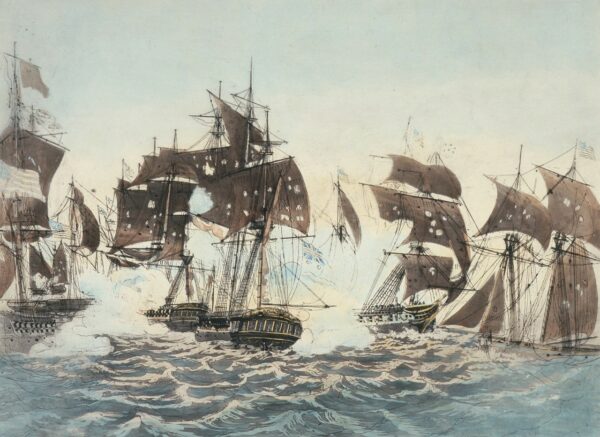
In December 1814, peace came with the Treaty of Ghent. Because he had not actually seen combat, Dobbins was snubbed in post-war accolades recognizing the importance of Perry’s victory on Lake Erie. This in spite being the godfather of the U.S. fleet on the Lakes. Given the selfless dedication he had displayed during the war, Dobbins believed he deserved much better treatment. Undoubtedly, the passage of time has proved his complaints justified; however, his self-righteousness and vanity did not help his cause.
Revenue Marine
The Rush-Bagot Pact of 1817—an agreement between the United States and Great Britain to eliminate their fleets from the Great Lakes, excepting small patrol vessels—dramatically reduced the Navy’s presence on the “North Coast.” The exception for small patrol vessels covered those for enforcing each nation’s customs laws, which would prove important to the development of the Revenue Marine on the Great Lakes. The perceived slights concerning Dobbins’s service during the War of 1812, combined with the opportunity to continue his naval career with the Revenue Marine, caused him to resign his Navy commission in 1826.
Prior to his resignation, Dobbins again deployed his political acumen, asking Congressman Robert Moore for retention of the naval station at Erie for use as a Revenue Marine facility and homeport for a revenue cutter. Dobbins envisioned that he would be appointed the commanding officer of that cutter. A cutter indeed would be built and commissioned in Erie, but it would be three years before Dobbins received a commission with the Revenue Marine.
With the end of the War of 1812, Dobbins was not the only naval officer seeking transfer to the Revenue Marine. While he did not receive the cutter command he desired, he did apply for and receive an appointment as an inspector of customs for the Cuyahoga District of Ohio—his foot was in the door. Continuing to politic for command afloat in Erie, he initially lost out to Capt. Gilbert Knapp. Knapp too was a veteran of the War of 1812, having served on the privateer Leo, running the British blockade, and delivering dispatches to France. He joined the Revenue Marine in 1819, commanding a cutter out of Detroit. Knapp gained a measure of renown for breaking up an extensive fur-smuggling ring in northern Lake Michigan near Mackinaw Island.
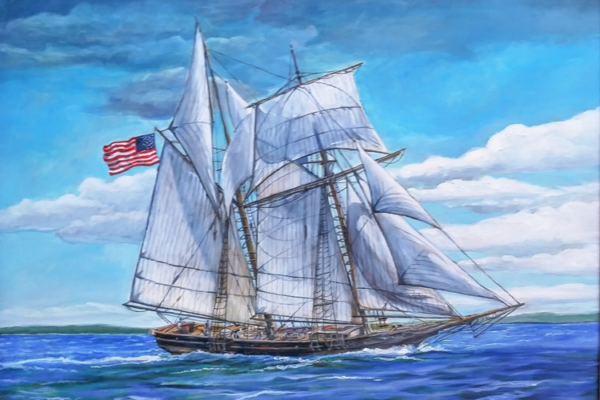
Knapp’s selection for the post in Erie was the first chapter in rivalry between Knapp and Dobbins. Interestingly enough, their rotating roles within the Revenue Marine had nothing to do with skill and competence. Both were accomplished mariners, respected vessel masters, and successful revenue cutter captains. It simply boiled down to the political practices of the time—the so-called “spoils system.” However, both Dobbins and Knapp sought the use of those idiosyncrasies to maximum personal advantage—creating decades of animosity between the two men.
The 1828 election of President Andrew Jackson changed everything. A Democrat, Dobbins had campaigned for “Old Hickory.” Knapp, on the other hand, had expressed publicly his displeasure with Jackson, allegedly calling him a cutthroat and murderer and his wife a prostitute. This political transgression would lead to Knapp’s dismissal. He was removed from command of the 30-ton revenue cutter Benjamin Rush on April 4, 1829. Dobbins was appointed his successor, thereby gaining what he had long-sought command of a revenue cutter in Erie.
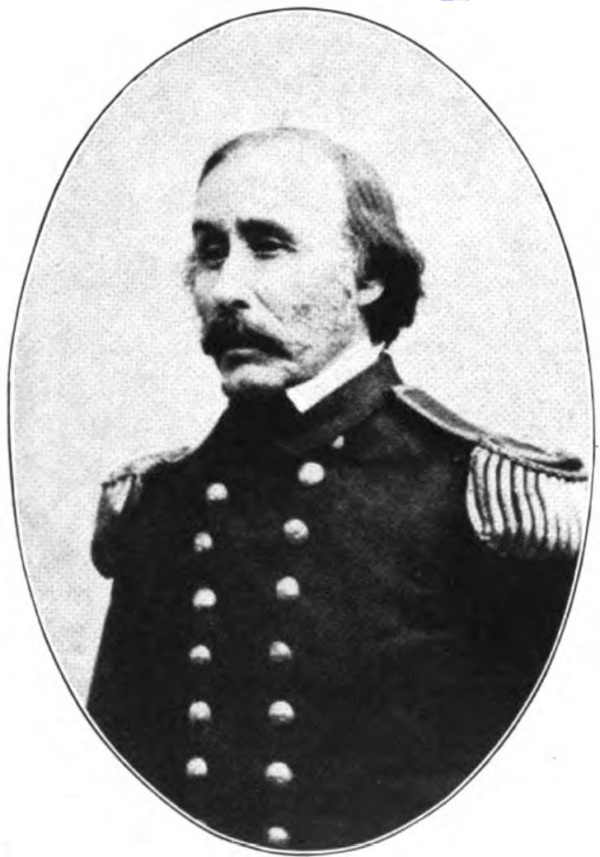
Dobbins was always interested in improving his hometown of Erie as well as his duty to his new service. He used his position with the Revenue Marine to press for harbor improvements and the addition of a second cutter to help stem the prolific smuggling that plagued Lake Erie. He did see an additional cutter assigned to Erie, but, in 1833, he took command of the recently built 65-ton Erie, which was larger and more capable than the Rush. However, Erie remained the only cutter to cover far too many miles of coastline and 15 years after his appointment to the Revenue Marine, Dobbins would still be pleading for more cutters.
The revolving-door saga of Dobbins versus Knapp continued. With the election of William Henry Harrison in 1840, the Whigs wasted no time in removing Dobbins and reinstating Knapp. Four years later, under the Democratic Administration of James K. Polk, the pendulum of political spoils swung the other way—Dobbins was in, and Knapp was out.
Over the course of his career, when not politicking for some cause, Dobbins was dedicated to protecting the revenue and enforcing the maritime laws of the United States. A good deal of his time was spent placing channel buoys, transporting supplies to remote lighthouses, rescuing vessels in distress, and visiting revenue collectors. Dobbins’ greatest commitment was stopping smuggling. The proximity of the U.S. to Canada and ever-increasing maritime traffic made this an acute problem for all customs officials. Dobbins continued to believe that the solution was simple—more cutters.
Beside interdicting smugglers, Dobbins’s most exciting experience was participating in the so-called “Patriot War.” In Upper Canada (present-day Ontario), a segment of the population was angered by the oligarchical rule of British officials and conservative traditions inherited from the attitudes of American Loyalists from the Revolutionary War. This group demanded reforms and, when rebuffed, they took up arms. Sympathy for the rebels ran high among many Americans. In late December 1837, Canadian loyalists burned and sank the American steamer Caroline, which the rebels had hired to ferry supplies. Angry Americans crossed the border at Detroit to support the rebel cause, creating a warlike situation in the region.
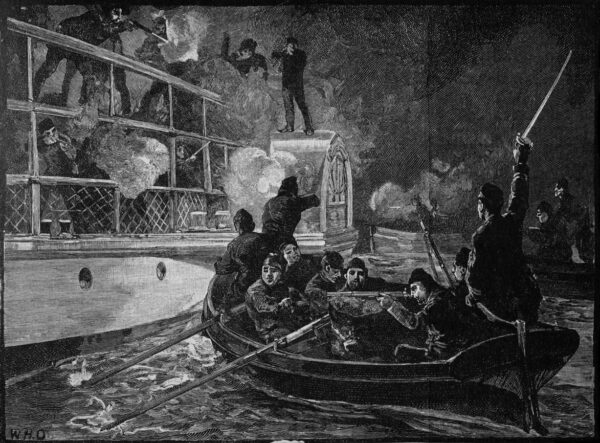
President Martin Van Buren called for strict neutrality and warned Americans not to become involved. He deployed troops and several vessels to the border to prevent support to the rebels. Dobbins and Erie were among those ordered to Buffalo and took part in several tense situations, including escorting an American steamer up the Niagara River in January 1838, with combatants from both sides massed along the riverbanks. Erie later was ordered to Detroit to prevent additional sympathizers from crossing the border.
In 1845, the political spoils system would see Knapp dismissed and Dobbins reinstated. The latter’s joy was dampened by command assignment to Cutter Taney in Norfolk, Virginia, rather than his beloved Erie. Angered, Dobbins resorted to his old habits: going around his immediate superiors to air his grievances. This time, he went to the top of the chain of command—President Polk. As one can imagine, Secretary of the Treasury Robert Walker was incensed, charging Dobbins with insubordination. In 1846, a disgruntled Dobbins, requested a three-month medical leave of absence, supported by a detailed physician’s report. Walker had little choice but to grant the leave. In 1847, using family and medical reasons, Dobbins managed a temporary assignment back to Erie.
With the 1848 election of Whig politician Zachary Taylor, Dobbins once again was dismissed, and his old rival Knapp reinstated. To many, this absurd in-and-out game had become a sad, running joke. Not a man to surrender easily, Dobbins once again took to writing letters and appealing to powerful friends—he had supporters on both sides of the political aisle. Dobbins did not need to defend his record; but neither did Knapp. Everyone knew that both men had been cruelly used as political pawns. This would be the last chapter in the silly game.
Predictably, Dobbins was unsuccessful in his bid for retention in the Revenue Marine. Instead, he became content to live out his life supporting his beloved community of Erie in other ways. He crossed the bar on Feb. 29, 1856. His funeral attracted a huge crowd of mourners.
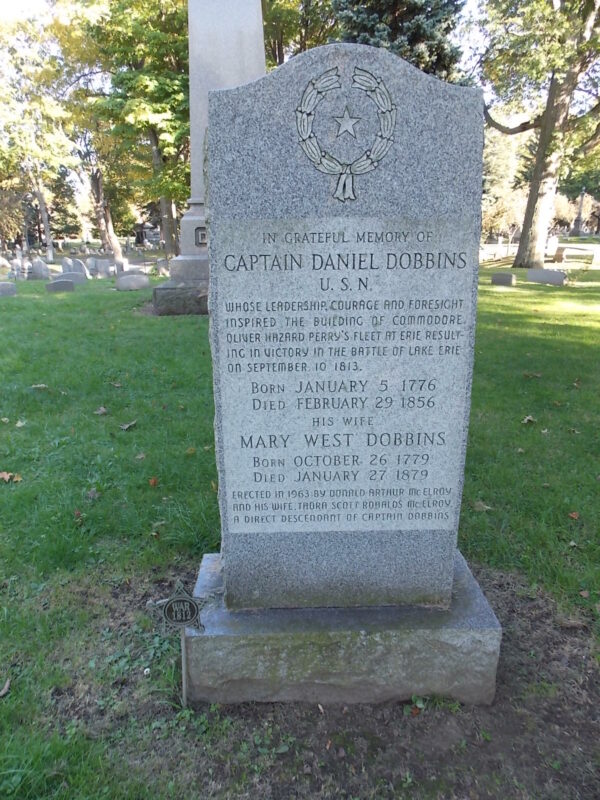
Knapp continued to serve honorably in the Revenue Marine; however, it was his pioneering and political accomplishments that formed his lasting legacy. During those times when the spoils system saw him replaced by Dobbins, Knapp used his vast knowledge of the Great Lakes to succeed as a merchant mariner. During one of his many cruises in Lake Michigan, he paused to explore the Root River region, which later became Wisconsin Territory. The 1833 Treaty of Chicago, signed after the Blackhawk War, opened settlement on the western shore of Lake Michigan. In a period between stints with the Revenue Marine, Knapp returned to the Root River and settled “Port Gilbert,” one of the first settlements in southeast Wisconsin. The community is now known as Racine, the French word for “root.” He also served in both the Wisconsin Territorial and State assemblies. His final command in the Revenue Marine was the Fessenden, one of the service’s early sidewheel steam cutters on the Great Lakes. He retired from the Revenue Marine in 1874, spending the remainder of his life in Racine, Wisconsin. He died in 1887.
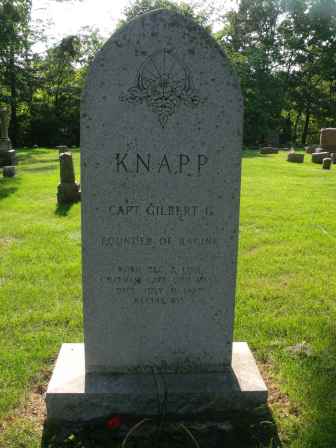
The story of Dobbins and Knapp is both sad and fascinating. Fascinating because of the positive impact the two men had on the early history of the Revenue Marine in the Great Lakes region as a whole. Both men shaped the future of their home communities of Erie and Racine. How much more impact could the two men have had on the history if not for the absurdity of the political spoils system of the early-19th century? We will never know.
National Coast Guard Museum insider tip: The story of the Revenue Cutter Service and the War of 1812 will be told in the First Hundred Years exhibit on Deck 3.
